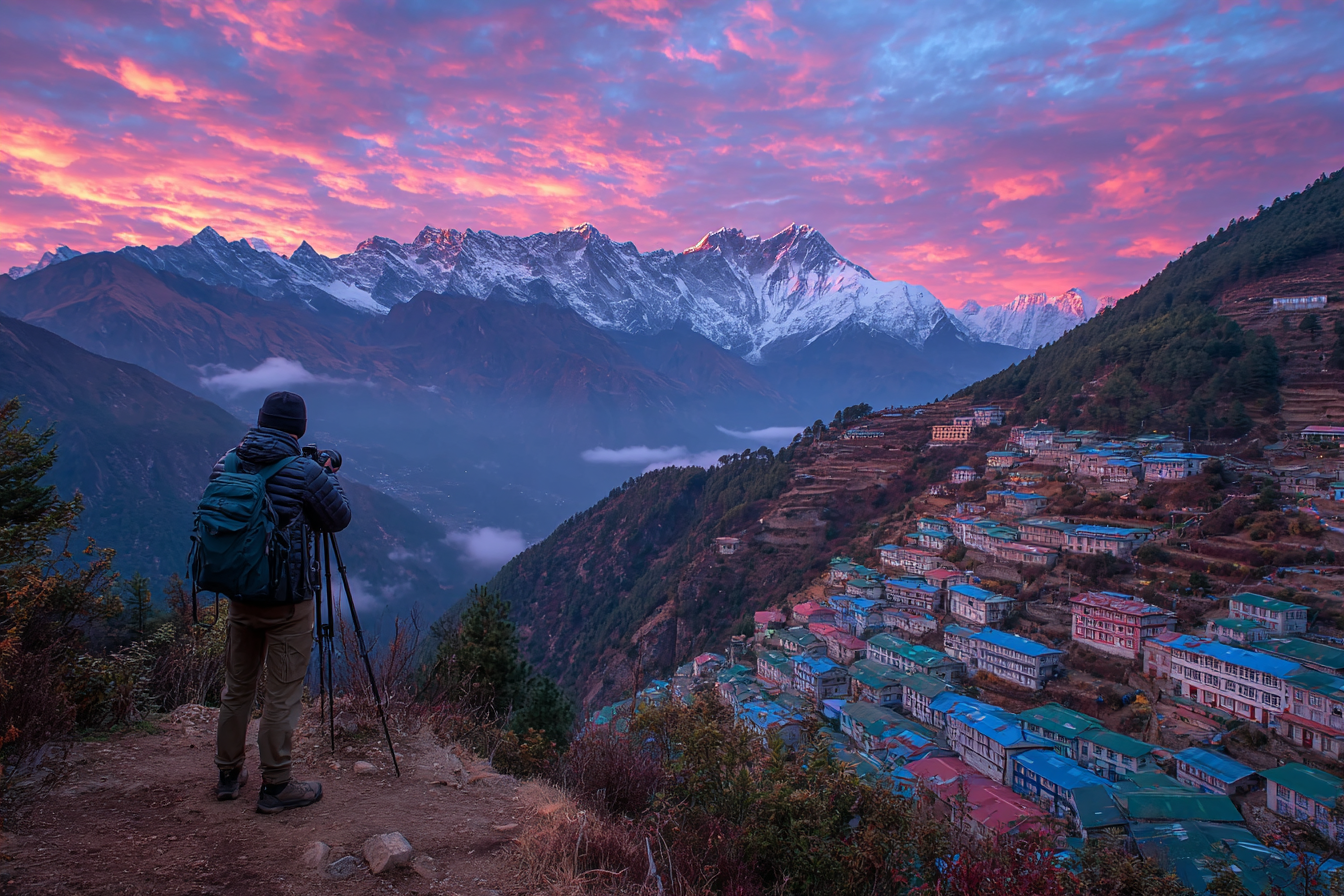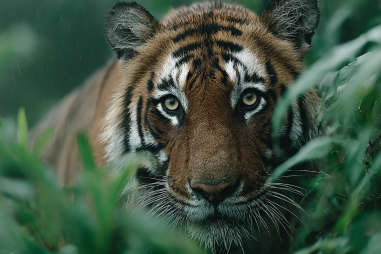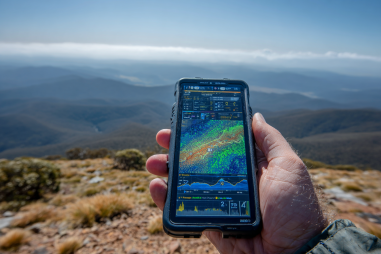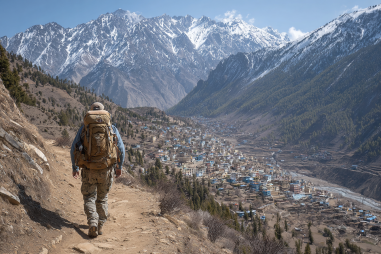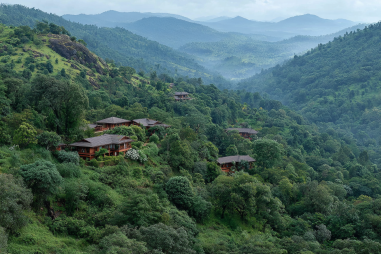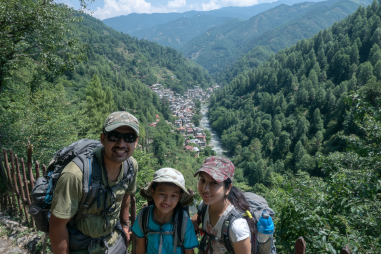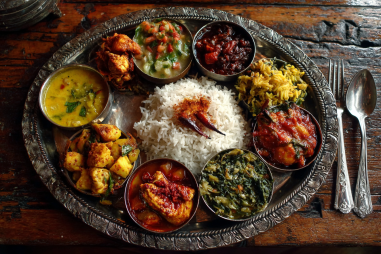Namche Bazaar, perched high in the Himalayas, is a photographer’s paradise. With its stunning mountain vistas, vibrant Sherpa culture, and ever-changing light conditions, it offers a wealth of opportunities to capture truly breathtaking images. Whether you’re a seasoned pro or an enthusiastic amateur, mastering the art of photography in this unique environment can make your memories last forever. Let’s explore some essential tips to help you capture the magic of Namche Bazaar and the surrounding Himalayan landscape.
Best Times of Day for Photography in Namche Bazaar
Timing is everything when it comes to photography, especially in high-altitude destinations like Namche Bazaar. The quality of light significantly impacts the mood and clarity of your photos.
The golden hours—shortly after sunrise and just before sunset—are perfect for capturing warm, soft lighting that enhances the natural beauty of the mountains and villages. Early mornings often offer clear skies and shimmering sunlight that casts dramatic shadows across the rugged terrain, making your landscape shots pop. Plus, the mornings are quieter, giving you better opportunities to photograph local life without crowds.
Sunset in Namche is equally magical, with the Himalayas often glowing in hues of pink, orange, and purple. Don’t miss the chance to capture Mount Everest’s silhouette alongside Namche’s colorful houses bathed in the final light.
Midday lighting tends to be harsh and flat, which can wash out details and colors, but can still work if you use it creatively — for instance, trying black and white or focusing on close-up shots where background glare is less of a concern.
Camera Gear Recommendations
Choosing the right gear is crucial for making the most out of your photography adventure in Namche Bazaar.
- Camera: A DSLR or mirrorless camera with manual controls is ideal for fine-tuning your settings in varying light conditions. However, modern smartphones with good cameras can also capture stunning images, especially with apps that allow manual adjustments.
- Lenses: A wide-angle lens (16-35mm) is great for sweeping Himalayan landscapes, while a medium telephoto lens (70-200mm) helps capture distant peaks and candid shots of local life without intruding. A fast prime lens (such as 50mm f/1.8) can work wonders for portraits and low-light shots.
- Tripod: A lightweight, sturdy tripod is essential for sharp images during low light, long exposures, or time-lapse photography.
- Filters: A polarizing filter enhances blue skies and reduces glare, while neutral density filters allow for creative long-exposure shots even during daylight.
- Extra Batteries and Memory Cards: The cold can drain battery life quickly, so carrying spares and ample storage is a must.
Composition Tips for Landscapes and Portraits
Composing a captivating photograph in Namche Bazaar combines understanding your environment with creative framing.
Landscapes:
- Use the rule of thirds to position mountains, valleys, or local buildings off-center, creating a balanced and engaging composition.
- Include foreground elements such as prayer flags, rocks, or flowers to add depth and scale, guiding the viewer’s eye into the frame.
- Seek leading lines like mountain ridges, paths, or rivers to naturally draw attention through your photo.
- Don’t shy away from panoramic shots when the scenery calls for it, especially on the ridge trails near Namche.
Portraits:
- Connect with your subjects — local Sherpa villagers are often proud to share their culture when approached respectfully.
- Use a wider aperture (low f-number) to create a beautiful background blur, emphasizing your subject against the rugged environment.
- Capture expressions and attire that tell stories about daily life, traditions, and festivals.
- Natural light is your friend. Aim to shoot portraits during soft morning or evening light for flattering skin tones.
Capturing Local Culture Respectfully
Namche Bazaar is rich in Sherpa heritage, festivals, and day-to-day life that are wonderful to document—but it’s important to do so with sensitivity and respect.
- Always ask permission before photographing individuals, especially in private or religious settings.
- Learn a few basic greetings in Nepali or Sherpa language to establish rapport and show respect.
- Be patient and observe – some of the best moments happen when people feel comfortable and unposed.
- Respect sacred sites and ceremonial practices by adhering to local customs and avoiding intrusive behavior.
By prioritizing respect, your photographs won’t just show beautiful imagery but connect viewers with the heart and soul of Namche Bazaar’s community.
Photography During Festivals and Events
Festivals in Namche Bazaar provide an extraordinary opportunity to capture vibrant cultural images filled with color, movement, and emotion.
Mask dances, traditional music, and communal celebrations are abundant, especially during events like the Mani Rimdu festival. To photograph festivals successfully:
- Plan ahead and find out the festival schedule and locations.
- Arrive early to secure a good spot and observe the proceedings before shooting.
- Use lenses with a longer reach to capture candid moments from a distance without disturbing performers or participants.
- Adjust your camera settings for fast shutter speeds to freeze motion or experiment with slower shutter speeds for creative blur effects.
- Capture details such as costumes, ritual objects, and expressions to tell a rich story.
Dealing with Challenging Weather and Light
The Himalayan weather is famously unpredictable, often changing rapidly, and that presents challenges as well as creative opportunities for photographers.
When clouds roll in or fog covers the valley, switch your focus from wide landscapes to intimate details—the textures of prayer flags, droplets on flowers, or faces glowing in soft diffused light.
Snow, rain, and wind require protecting your gear with rain covers and lens cloths. Cold weather drains batteries faster, so keep spares warm and rotate usage.
Bright sunlight at high altitudes can be harsh: make use of lens hoods, polarizing filters, and shaded spots. Shoot in RAW format to preserve as much image data as possible for post-processing corrections.
Editing and Sharing Your Photos
Post-processing can elevate your Himalayan images, bringing out the vibrancy and clarity you experienced in person.
Use editing software like Adobe Lightroom or free alternatives such as Darktable to:
- Adjust exposure and contrast to balance light and shadow.
- Enhance colors to reflect the natural beauty without overdoing it.
- Sharpen details, especially in landscape shots to highlight textures.
- Crop for better composition if necessary.
- Correct lens distortions or chromatic aberration.
When sharing your photos, consider platforms like Instagram, travel forums, or photography groups to inspire others and connect with a community passionate about Nepal and the Himalayas.
Weaving Your Own Himalayan Story Through Photography
Namche Bazaar is more than a photographic destination – it’s a story waiting to be told. Your images can convey the awe-inspiring landscapes, the warmth of Sherpa culture, and the spirit of adventure found at the roof of the world.
By choosing the right times, gear, and compositions, practicing respectful cultural engagement, and embracing the dynamism of mountain weather, your photos will capture the essence of the Himalayas’ magic. Each shot becomes a chapter in the narrative of your journey, inviting others to experience the wonder of Namche Bazaar alongside you.

